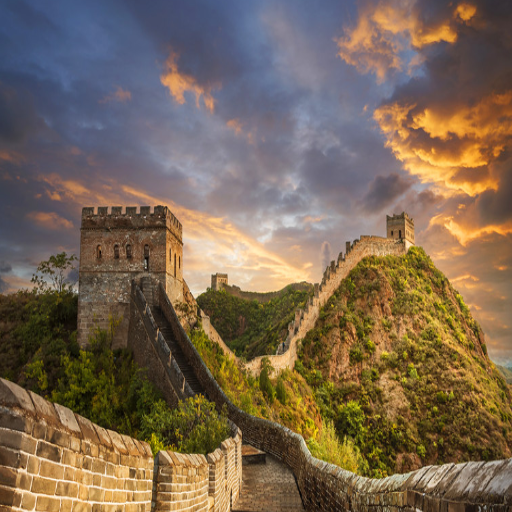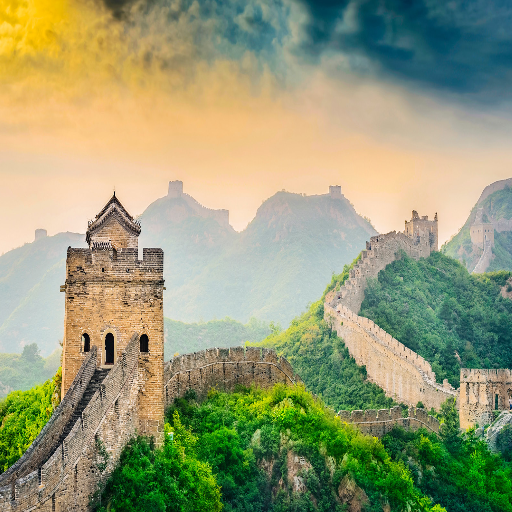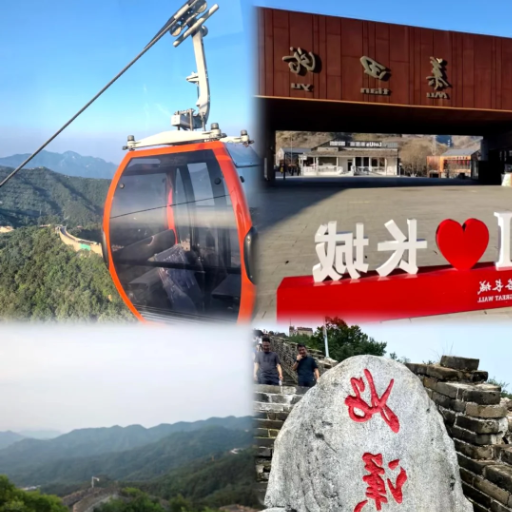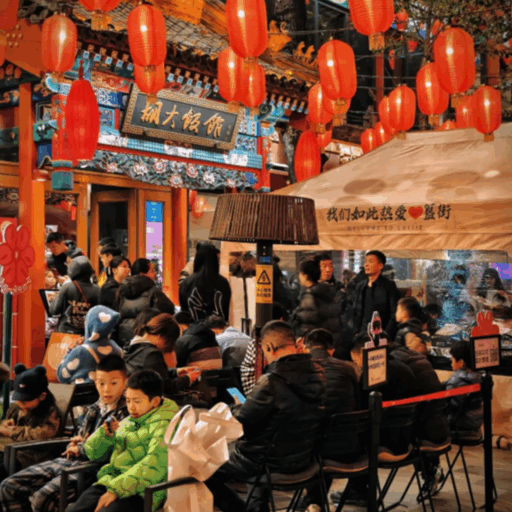Beyond an architectural wonder, the Great Wall of China represents timeless perseverance, history, and human innovation. This iconic structure spans remarkable landscapes, rugged mountains, and endless deserts, inviting travelers to immerse themselves in stories from a bygone time unlike any other. The wall spans over 13,000 miles. This blog post serves as your ultimate guide to experiencing the wall. We provide information on the wall's captivating history and fascinating anecdotes that we promised you, as well as sections of the wall that are so mind-blowing, they're a must-see. We also offer details like tips and essential sections, which will make your journey unforgettable. So, whether you're a history buff, an adventure lover, or someone eager to witness the world's wonders, this article is sure to create unforgettable memories. Get ready to marvel at the remarkable landmark while stepping back in time.
What is the Great Wall of China, and Why Visit?

Chronology of the Great Wall of China
It is pretty well-known that the Great Wall of China is one of the most critical structures in the world. Its beginnings can be traced back over 2,000 years, specifically to the 7th century B.C.E. During that era, 'The Great Wall' was simply a series of walls built by different states. These walls were constructed during the Warring States Period and served as a sole defensive shield against nomadic invasions from the North. Additionally, these fragmented walls were consolidated into a single, unified wall by China's first emperor, Qin Shi Huang, in the 3rd century B.C.E., thus marking the start of the Great Wall.
Later on, walls built by the Qin were strengthened and rebuilt by his descendants, mainly the Ming, after the Ming dynasty stopped the nomadic invasions. The period within the Ming dynasty, from 1368 to 1644, was when the Great Wall underwent its most significant phases of construction. Large chunks of the wall were rebuilt entirely using modern construction materials, such as stone and bricks. Eventually, the Wall served not only as a defensive barrier but also as a monumental statement of Chinese strength and protection when it reached over 13,000 miles in length.
Apart from defending the Chinese Empire, the Great Wall of China allowed trade to be conducted more efficiently on the Silk Road, helped control the movement of people, and projected the empire's power. Now, it is regarded as an ancient relic, a cultural landmark in China, and a national symbol that attracts millions of visitors to appreciate both its history and the surrounding natural scenery.
Why We Should All Visit the Great Wall
In addition to being a massive wall over 13,000 miles in length that crosses various terrains, including mountains, deserts, and plains, the Great Wall of China is also a remarkable piece of engineering. The construction of this wall represents hundreds of years of work by different dynasties, including Qin, Han, and Ming; this is why it is considered a UNESCO World Heritage Site. Each section of the wall was built using diverse construction methods and enduring materials, such as bricks, tamped earth, and stone, demonstrating architectural beauty that withstood the test of time.
The panoramic views of China's landscapes serve to attract visitors. Badaling and Mutianyu are easily accessible, iconic portions of the wall with restored pathways, while more remote areas are suited for hikers. The Great Wall of China provides unparalleled insight into the country's remarkable history, revealing the incredible fortitude and conviction of its people. It doesn't matter whether you love History, nature, or adventuring, the Great Wall promises everyone a surreal experience that blends the bygone and modern worlds.
Best Time to Visit the Great Wall
For most guests, China's spring (April to June) and autumn (September - early November) are the most pleasant and comfortable periods to visit the Great Wall, although summer (June to August), and winter (December to February) are some off peak periods. Spring has powerful weather, milder temperatures, and flowers and greenery, while autumn boasts awe-inspiring golden foliage along the ridges for photo opportunities.
Daylight is more abundant during summer (July-August), enabling travelers to venture deeper. However, the heat and humidity can be intense, especially at the more crowded tourist sections such as Badaling. For those who prefer quiet experiences, winter, from December to February, offers its distinctive appeal. Although the temperature drops sharply, the snow-covered Wall possesses an entrancing, almost surreal charm. Visitors during this time can also enjoy the solitude of fewer tourists, which allows for a more introspective and deeper journey.
Be mindful of the climate and the particular section of the Great Wall you plan to visit. While some areas, like Mutianyu, are well-kept and open year-round, others may become inaccessible due to severe weather. Regardless of the season, arriving early, staying hydrated, and dressing appropriately enhance your experience.
What to Expect on a Great Wall Tour?

A List of All Available Tours of the Great Wall
The variety of tours the Great Wall offers guarantees that they will find an experience that aligns perfectly with their likes and preferences. Guided tours are among the most popular options, as they provide visitors with essential information. Such details include information about the Great Wall’s construction history, cultural significance, and its role throughout history. Guided tours come with transportation, which is a plus for people visiting Badaling or Mutianyu.
Hiking tours are a great option for adventurers. These tours also offer participants parts of the wall that are wilder and haven’t been restored like Jiankou or Gubeikou. This ever-changing, authentic landscape makes the hike even more interesting and challenging. People can also enjoy the Simatai section, which is illuminated at night for stargazing, making their experience even more enjoyable. For high-end customers, private tours and helicopter tours offer luxury, incredible comfort, and magnificent views of the sprawling Great Wall and China's landscapes.
Lastly, the multi-day tours, which include visits to the Great Wall and other culturally significant sites, such as the Forbidden City or the Summer Palace, offer a fulfilling travel experience. As always, each type of tour has unique characteristics that cater to different types of curiosity or levels of exploration.
What is a Private Tour of the Great Wall?
A private tour of the Great Wall of China has specially tailored features such as exclusivity and flexibility. This allows the particular traveler to have a closer experience with one of the world's wonders. Unlike group tours, a private tour is designed for one specific individual, which means their interests, schedule, and checklist dictate the journey taken. This guarantees a more profound and personal discovery. Guests usually have the guide's full attention and thus receive complete insights into what the wall has to offer, from its history and engineering to modern culture, all while respectfully waiting for questions. For instance, someone focused on the ancient military strategies behind the wall's construction or the folklore surrounding its existence will be catered to endlessly by a private guide.
Typically, these tours encompass the sections of the Wall that best suit the traveler's pace and level of interest. For example, less prominent sections, also known as “wild” sections of the wall, such as Jiankou or Gubeikou, are ideal for hikers seeking rugged scenery. On the other hand, more popular areas like Mutianyu and Badaling are convenient for families and casual visitors, as they offer cable car access, smooth pathways, and panoramic views. Many private tours also offer additional services, such as air-conditioned cars, fine dining, and avoiding tourists by providing access to the wall before sunrise.
By combining the private tour option with custom requests, such as photography sessions, extended hiking, or visits to local cultural attractions, consumers can create a uniquely unforgettable personal narrative. Private tours of the Great Wall offer unique opportunities for visitors to tailor their experiences and form meaningful connections to the landmark.
Guided tours vs self-guided trips
Both types of trips come with their advantages and great specific features. Usually, a traveler's preference guides them in choosing a style or option based on their needs, expectations, and experiences. Going on guided tours is more likely to promote better learning, streamlined experiences, and more enjoyment. During guided tours, professional guides explain the history of the place, share stories related to the spot, and highlight special interests that most tourists often overlook. Even logistical nightmares like transportation, language barriers, and permits are taken care of; thus, travelers can relax entirely without worrying. A guided tour helps only tourists experience a new culture by enabling the traveler and local community to interact, or allowing them to witness regional customs. This was discovered in a 2023 survey on the graph and importance of guided tours to culture.
Self-guided trips are the best option for people who appreciate freedom, adaptability, and accept a good challenge. Individual travelers appreciate not being bound by the rigid schedules and follow-the-leader mentality of structured holiday programs. Tourists can move at their own pace, attend to personal priorities, and change their travel plans on a whim. Self-guided trips are economical and cost-friendly, particularly useful for travelers who are well-versed about a particular destination and its surrounding areas. On self-guided tours, such as those to the Great Wall, visitors can escape the crowds and stress of daily life to explore the breathtaking, less-traveled remnants of the world. In the end, whether to go on a guided tour or a self-guided trip depends on how much convenience is needed, how much is spent on the trip, and how deeply one wants to delve into the area.
How to Choose the Best Section of the Great Wall?

Mutianyu vs. Badaling: Which One’s Better?
While both are part of the Great Wall, each has its appeal and caters to different traveler styles. Badaling is famous for being the most complete and representative section of the wall. As such, it is also the easiest to access. Badaling features exceptional visitor services; however, because it is the most popular section of the wall, it experiences high volumes of travelers, especially during peak season.
Mutianyu, on the other hand, is less crowded, offering visitors a peaceful alternative, making it appealing for those looking to escape the bustling sites. In addition, the wall at Mutianyu is surrounded by hills covered in lush greenery, adding to its scenic beauty. This section also boasts a selection of well-maintained paths, numerous watchtowers, and even toboggan rides, making it ideal for all adventurers and families.
When deciding between the two sections, it's essential first to assess what you hope to get out of the trip. If you prefer convenience and easier access, you wouldn't go wrong with Badaling. But for those looking for scenic beauty and a peaceful atmosphere, Mutianyu is a better option.
Discovering the Beauty of the Jinshanling Section of the Wall
The Jinshanling section of the Great Wall is famous for its architectural beauty, distinctive characteristics, and lesser-known locations, making it a popular spot for hiking and photography. Approximately 80 kilometers northeast of Beijing, Jinshanling offers visitors a glimpse into the history of the Great Wall and preserves it in beautiful condition. This section is roughly 6 miles in length and contains more than 20 watchtowers that were strategically placed to allow roaming and exploring the elaborate defensive structures.
The blend of gold and the raw mosaic of nature is precisely what Jinshanling is famous for. It offers a mix of both restored and unfinished pieces, allowing tourists to admire the Great Wall while also seeing it in its original form. This wall is also famous for its eye-catching landscape. Its beauty is unmatched due to the endless sea of hills, rough mountains, and steep slopes. Photography fanatics will have a field day with the lighting during early mornings and late afternoons, as well as the captivating angles and sharp colors, along with the walls, that make the region irresistible.
Moderately adventurous travelers will find the hike here to be a bit challenging, as it involves steep elevation gains and navigating broken steps. Those looking for an easier wall will appreciate the cable car that goes to the upper levels of the wall. This ensures that people of all ages and physical abilities can enjoy the wall. If you're intrigued by the deep history, the more remote parts, or the stunning sights, then don't miss out on visiting Jinshanling, as it's one of the best Great Wall locations that showcases China's history and craftsmanship.
Best-Preserved Parts of the Great Wall
The Great Wall of China stretches for thousands of miles, with different sections celebrated for their preservation and unique characteristics. Among these sections, Mutianyu is one of the most well-preserved and easiest sections of the wall to hike. It is located around 45 miles northeast of Beijing, so it's a bit of a hassle to get to, but it's worth it. This segment has been heavily restored and has 23 original watchtowers and fortified walls that weave throughout the forested mountains. Visitors here are greeted with stunning panoramic views, invigorating hikes, and can even take a cable car.
Another astonishing section is Jiankou, famous for its wild and rugged terrain. Although less restored than other sections, Jiankou's unpolished charm captivates hikers and photographers alike. Its steep, narrow paths, sharp verticals, and dense foliage—along with the towering mountain backdrop—make this section highly scenic and multifaceted.
Simatai, known for its untouched character, features a striking combination of original brick and well-preserved terrain. Unlike other sections, Simatai allows visits after dark, offering guests the unique experience of viewing the Great Wall bathed in moonlight. Travelers looking for authentic rests admire this piece of history not only for its architecture—merged with breathtaking views—but also for its rich past.
Lastly, the Badaling section, while the most visited, is known for its superb restoration and historical value. Heavily equipped with modern facilities, it draws millions of visitors each year, making it well-suited for families and casual explorers looking to experience the world's wonders.
These restored sections of the Great Wall showcase the enduring legacy of the wall, while also providing a glimpse into its history, architecture, and culture as a UNESCO World Heritage site.
How Can You Enhance Your Great Wall Experience?

Best Workout Practices for Walking on The Great Wall
To get the best value out of the Great Wall of China, preparation is essential. Make sure to select the wall section that aligns with your interests and fitness level. For example, Badaling is highly restored and easily accessible to casual visitors, while Jiankou and Simatai are far more suited for brave trekkers looking for a less trodden, rugged experience.
As the wall consists of different terrains such as steep inclines, hills, winding paths, cumbersome stone steps, and other obstacles, “sturdy, comfy footwear” is required. Weather changes are an important factor to consider, clothing must be in layers while additional essentials such as water, sunscreen, and light apparel will aid in easier maneuvering for long walks.
Apart from weekdays being less busy, early morning and late afternoons also provide the best experience, free of heavy foot traffic. Crowds and breathtaking views, accentuated by the towering sun, combined with weekdays, make the experience tremendous while setting a relaxed tone, making it the perfect time for a visit. To finish, didactic care is a must; children's explorers should not touch the designated areas guides have set to avoid littering and damaging the masterpiece for future generations.
Tips on What to Bring On Your Tour
Properly packing for your tour can ensure a pleasurable experience. Start with good-quality clothing and shoes, particularly if the tour involves long walks on uneven surfaces. In case the weather changes, a light jacket or rain poncho is essential. Don’t forget a refillable water bottle so that everyone can stay hydrated. Lastly, a wet cap or sunglasses will shield one from the sun.
A good-quality backpack can protect sunscreen, a small-sized first aid kit, and snacks, which could provide extra energy. For those passionate about photography, a lightweight camera or smartphone, along with a charger like a power bank, makes capturing special moments easy. Besides, a guidebook, a notebook, or an application can provide interesting additional data alongside the ones you’ve already gathered concerning the places you visit. Make sure to constantly personalize your packing list to meet the unique needs of your destination for a hassle-free experience.
Local Guides and Their Importance
Local guides are handy for everyone visiting new destinations because their insights are often critical to ensure that the experience has a positive value. Their expertise also applies to history, culture, geography, and even places off the beaten track. Unlike standardized travel pieces and guidebooks, local guides tailor their viewpoints and interact with the tourists at a deeper level, allowing them to experience the place beyond its surface. They recount stories and experiences that have been woven into the lives of people over many years and seasons, adding an extraordinary dimension to the trip. From visiting historical sites and landmarks to sampling regional dishes or exploring the countryside, a local guide ensures that you fully appreciate the significance of everything you see, hear, and do.
In addition, local guides aid in sustainable and responsible tourism practices. They help promote local businesses, craftsmen, and other hidden gems. This helps distribute the advantages of tourism throughout the community. They also know local customs and ecological practices to make sure visitors interact with the culture and environment appropriately. For example, they might suggest how to handle specific actions at sacred places, promote green behavior, or take the most ecologically conscious paths. An experienced guide not only maximizes the fun on your trip but also strengthens the bond between travelers and the places they visit, making it a more responsible experience.
How to Plan Your Day Trip to the Great Wall?

Finding Your Hotel Near Beijing
With the plan to visit the Great Wall for a day, my local hotel choice was crucial. I used to book a hotel with Great Wall tour pick-up points. Avoid the Great Wall travel route pick-up spots. Many central hotels, like those in Dongcheng or Chaoyang, are located near a train and bus station, which allowed me to sleep in during my commute, as I could simply hop on a bus or train.
Equally crucial for me was the comfort and enjoyment the hotel’s practical facilities would give me. Having a good shaped breakfast was high on my priority. Also, from my trips concierge, I required Responsive staff who have working relations with touring luggage-free mornings, along with keeping my travel light. Booking deals with guides who can tailor recommended packages to fully experience Mutianyu or Badaling, including shuttle transportation to avoid dealing with hotels that act as packs of cheap guides who give them cushions for their packages.
After my extensive research, I was able to book a hotel that balanced the three factors of quality, affordability, and accessibility. As a result, I was able to fully make the most of my day at the Great Wall of China. I was able to spend significantly less time worrying about logistics and more time soaking in the historical beauty of the wall.
Enriching My Trip with Other Attractions
As it turns out, combining the Great Wall with other attractions is a splendid way to enrich my trip. Considering the Great Wall is located outside Beijing, I took the opportunity to visit some additional sites. For example, after exploring the Mutianyu section, I stopped at the Ming Tombs, a UNESCO World Heritage site that offers insight into China's imperial history. The other landmarks were close enough to create an efficient itinerary while still offering diverse cultural experiences.
Another standout part of my trip was driving through the countryside and having a meal at a family-run restaurant in the village. Not only did I get to experience authentic Chinese food, but it was a nice escape from the crowds at the Wall. Another option for me was to combine the visit with a trip to the Summer Palace in Beijing. I ate at the Wall during the Wall’s opening hours, and in the afternoon, I leisurely strolled around the tranquil gardens and lakes of this palace.
In the end, while the Great Wall remains the focal point of the visit, merging it with other places helped me appreciate the history and culture more fully. It enhanced the experience while rounding out my day. It was much more memorable. If there are any travelers out there who would love to explore such a place, I suggest creating a schedule that incorporates both enhanced stops and famous landmarks.
Registration and Pre-Purchase: Why It's Important
Effectively, planning means far easier and simpler itineraries, for me at least, especially when it comes to famous landmarks. I am given a higher guarantee that I will be able to get into my preferred sites. I also avoid queuing for hours and save a substantial amount of time on the trip. Knowing that the tickets have been sorted gives me an inner sense of satisfaction, which lets me concentrate on the joyful moments instead of worrying about last-minute issues.
Being able to often take advantage of discounts or special promotional prices that are only available before your visit is another added benefit of booking far in advance. Many times, I have come across instances where purchasing tickets early unlocks early-bird rates or combo packages, which significantly reduce ticket fees. Having these options helps dramatically improve how the plans are executed step by step and also allows us to ensure we tune our visits around optimal weather conditions.
Making preparations ahead of time is something I have learned personally, especially when traveling to major attractions or seasonal hotspots. Pre-purchasing tickets has consistently improved my travel experiences, ranging from access to limited-entry exhibits to avoiding sold-out tickets and even saving money in the long run. Pre-purchasing tickets saves time, ensures a hassle-free visit, and improves my overall travel experience.
Frequently Asked Questions (FAQs)
Q: What can I expect on a Great Wall of China tour experience?
A: With each step, a breathtaking view awaits you to capture on your camera. On a tour of the Great Wall of China, you will get lots of historical insights in addition to beautiful views, and ample chances to get a thorough heritage exploration of the Great Wall’s sections. As one of the seven world wonders, the Great Wall’s history is extensive and most English-speaking guides cover all the important details during the trip.
Q: How do I get to the Great Wall from Beijing?
A: For travelers staying in central Beijing, multiple transportation options exist. Most tours include taking customers from their hotel to the city center to the wall. Alternatively, trips are offered that begin in Beijing, featuring sections of the wall, such as Huanghuacheng or Jinshanling. Fans of the DIY travel style also have public transport at their disposal.
Q: What is the best section of the Great Wall of China to visit?
A: The best section of the Great Wall of China to visit will be dictated by your interests. For families and first-time visitors, Mutianyu Great Wall is famous for its easy access and cable car service. If you want less crowded experiences, the unrestored Jiankou and Jinshanling sections offer gorgeous sights and fewer people.
Q: Are there any cancellation policies for the Great Wall of China tours?
A: Yes, several tour companies have restrictions on free cancellation up to a specific time before the tour. After booking the trip with a provider, it's wise to verify the conditions for refunding money associated with the journey, especially when booking from Beijing.
Q: What should I include in my itinerary for a trip to the Great Wall and the Forbidden City?
A: The itinerary for a trip to the Great Wall and the Forbidden City should include the Great Wall in the morning, followed by visiting the Forbidden City in the afternoon. Give yourself enough time in between both locations, factoring in travel, and consider local restaurants to experience genuine Chinese food.
Q: Se puede usar el teleférico en la Gran Muralla China?
A: Sin duda, existe la opción del teleférico en Mutianyu y en otras secciones de la grande muralla. Este servicio le permitirá a los visitantes alcanzar la parte más alta de la muralla sin necesidad de realizar una ardua escalada. Esto es especialmente útil para aquellas personas que no pueden subir mucho debido a problemas de salud.
Q: Cuanto dura un tour de un dia desde beijing a la gran muralla?
A: En promedio, un día al gran tour a la gran muralla desde Beijing dura seis horas en total, todo incluido, a partir de transporte, la exploración de la muralla y la ciudad prohibida y el tiempo que pase en los mercados locales.
Q: Qué debo poner al visitar la Gran Muralla?
A: Si te gusta escalar, zapatos cómodos y apropiados para la sección de la muralla en que pasearás son obligatorios (no pienses en tacones). Si eres una persona aburrida, tu ropa también debería ser apropiada a la Josefa o a la temperatura del lugar. Si tienes planes para escalar en las partes no restauradas de la muralla, calzado resistente es fundamental.
Q: Hay facilidades en la gran muralla?
A: Por su popularidad, grande algunas secciones como Mutianyu, tienen venduteros, restaurantes y hasta souvenirs disponibles. En las secciones no restauradas, chuiren pos hace cal סוף בהם cha ano, no hay planes para su mejora, entonces son escasos, por ello hay que tenerlo en mente.


